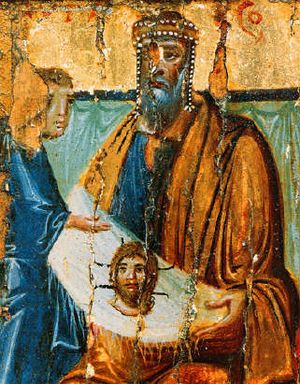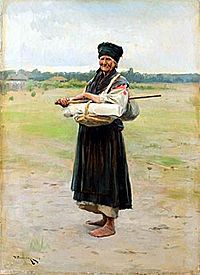Nut Feast of the Saviour facts for kids
The Nut Feast of the Saviour is the third spas feast of the Saviour which celebrates the Holy Mandylion of the Lord. It is celebrated as the afterfeast of the solemnity of the Dormition. After the Honey Feast of the Saviour and the Apple Feast of the Saviour, the Nut feast is therefore placed on August 16 in the Julian calendar and on August 29 in the Gregorian calendar.
Contents
Etymology
The third Spas is known as the Nut feast of the Saviour because in most places in central Russia, nuts ripened at the time of the year in late August when this festival is celebrated.
This festival is also referred to as the “Savior on Canvas”, “Savior on Canvas”, “Canvas Spas” - from this day they sell homespun canvases; "Bread Spas" as it also matches the time when the harvesting of the wheat end and the first new bread is baked. It can also be called "Autumn Spas" when winter grains are sown.
Liturgy
This liturgical afterfeast which is known technically as the feast of Our Saviour of the Mysterious Image is considered a "Small Spas" - or a semi-holiday - in contrast with the major feasts of Jesus Christ.
The tradition is to organize processions outside the church as well as special blessings on this occasion.
The liturgical ordo however is not connected to the popular feast but to the celebration of the Holy Mandylion which Vespers and Divine Liturgy.
Origin
An agricultural autumn festival
On the third Savior, birds fly away, especially swallows and cranes. It is believed that swallows fly off at three Spas. If the crane flies off to the third Spas, then it will be frosty on Pokrov, the feast of the Intercession of the Theotokos. Vladimir Dal, in the interpretation of the farmer's calendar, compiled according to folk signs and observations, gives an original view: “Winter flask on trees promises, as they say, a good harvest for bread; a harvest of nuts promises a plentiful harvest of grain for the coming year, at least it has been observed that a strong harvest of nuts and bread is never together; that, moreover, there is never a great harvest of nuts for two years in a row; therefore, with an abundance of nuts, there will be no next year, and probably there will be a harvest for bread. Returning to the name of the third Savior, called “bread” or “nut”, the people celebrated it as a day of thanksgiving to the Lord for daily bread for every day, which is heard in folk proverbs and sayings: “The Third Savior has stored bread”, “It’s good if the Savior - on the canvas, and the bread is in the threshing floor!
However, the feast of Our Savior of the Mysterious Image was much less an agricultural feast than the two other minor Spas , so much so that when it was forbidden by the Soviet Union, believers knew little about it as it was not in any way associated with farming practice.
A historical commemoration: the lost image of Edessa

On this day, the Slav Orthodox Christians also celebrate the translation of the Holy Mandylion. The image was considered an acheiropoieta icon "not made by the hand of man" similar to the Shroud of Turin, with which it is sometimes associated. Coming from Jerusalem, it was moved to Constantinople in the 10th century. During the Arab occupation of the city in 944, Emperor Constantine VII bought this image from the Emir and with great honors transferred to Constantinople, the Church of the Blessed Virgin.
This translation which was later interpreted as its "removal" is the historical event commemorated during the Nut Festival. The cloth disappeared when Constantinople was sacked in 1204 during the Fourth Crusade, and is believed by some to have reappeared as a relic in King Louis IX of France's Sainte-Chapelle in Paris. This relic disappeared in the French Revolution.
The feast of Diomedes
On this day, Slav Orthodox Christians honor the physician and martyr Diomedes of Tarsus, who is prayed for with various ailments and illnesses.
This festival also honors the Feodorovskaya Icon of the Mother of God, before which women pray for a safe delivery.
Traditions
An urban rather a village tradition
In most villages in Russia, there were no big holidays on this day, as preparations began for the completion of summer field work before the onset of rains. In the cities from this day Velikodensky Carnival begins, as in Valdai for example.
In the steppe provinces of Russia, winter crops usually begins to be sown three days before Obzhynki and finished within three days after Obzhynki. On this day, bread is baked from the grain of the new crop. The dates were adjusted depending on the weather and harvesting of spring crops. Sometimes we dropped out earlier to the Apple Feast of the Saviour.
Blessing of the canvasses
It is customary to bring canvases to church in order to receive a special blessing. These canvas are an echo to the Holy Mandylion, and prayers are made so that the canvas of man, may be as beautiful as the icon not made by hands of man.
Harvesting of nuts
Harvesting of hazelnuts also began from the third Spas. Using holy water, a specific blessing of the nuts takes place during the celebration.
On this day, slavic households prepare festive dishes with nuts such as pies with mushrooms and dishes with nuts. Nut-based pastries are also prepared such as baked apples and sweets with nuts, as well as necessarily freshly baked bread using the new crops.
Literature
In The Living Grace: A Ukrainian Legend written by Liudmyla Starytska-Cherniakhivska, the events unfold during the Nut feast of the Saviour and the two other minor spas.
After years of atheistic communism, renewing such popular religious feasts was part of recovering the soul of Holy Russia according to dissident authors such as Andrei Sinyavsky.
Related articles
- Honey Feast of the Saviour
- Apple Feast of the Saviour



